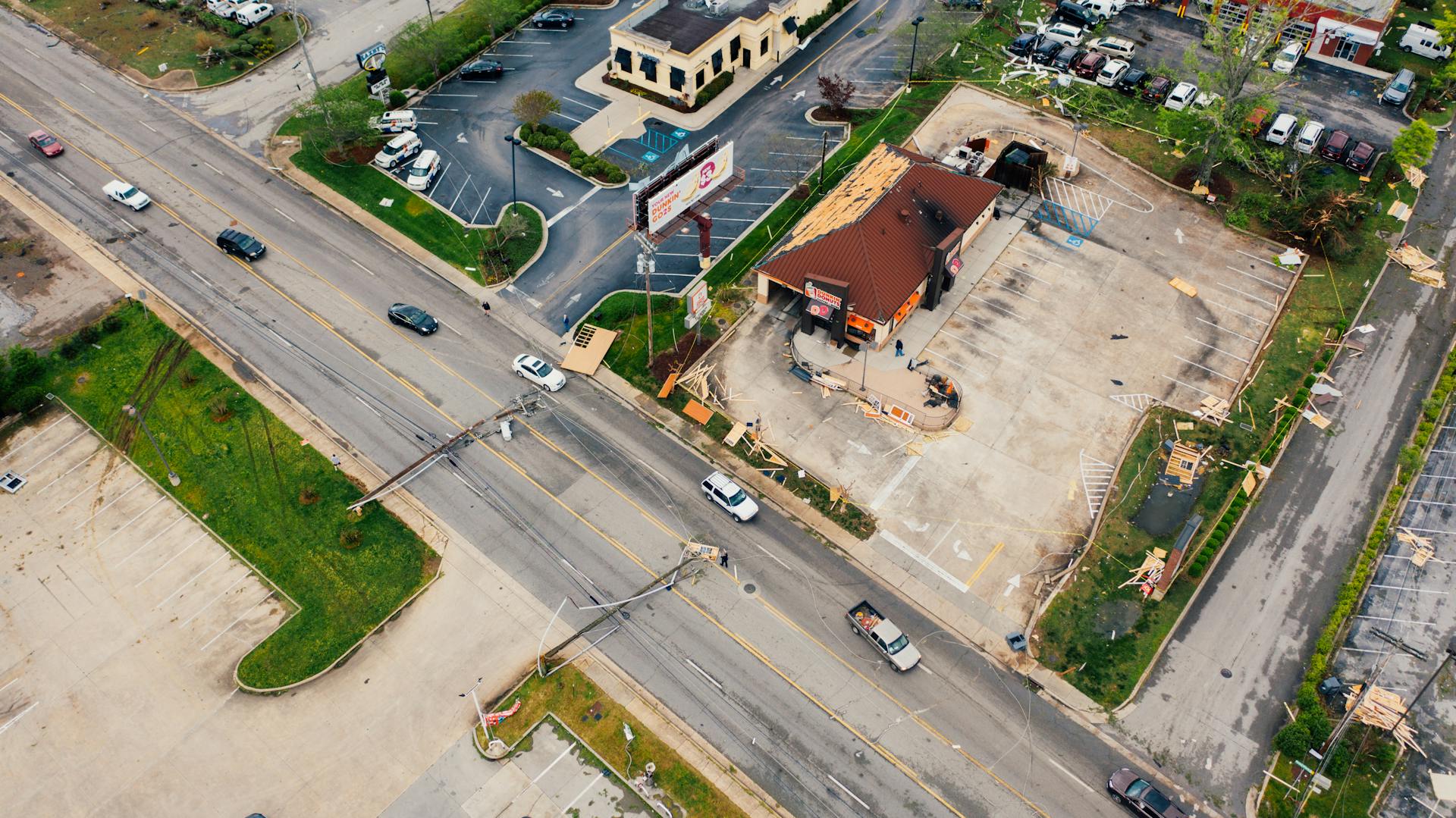
Filing a storm damage insurance claim can be a daunting task, but with the right guidance, you can navigate the process with ease. Start by gathering all relevant documents, including your insurance policy, proof of ownership, and any photos or videos of the damage.
Take clear and concise photos of the damage to your property, including any broken windows, damaged roofs, or flooded areas. This will help support your claim and provide visual evidence of the extent of the damage.
Next, contact your insurance provider as soon as possible to report the damage and initiate the claims process. Be prepared to provide detailed information about the damage, including the date and time it occurred.
Broaden your view: How Does a Insurance Claim Work
Assessing Storm Damage
Assessing storm damage is a crucial step in the insurance claim process. Start by recording the date of the storm, as this will be an essential piece of information for your insurance provider.
Take note of any signs of damage you can see from the ground, such as fallen branches or debris scattered around your property. Don't forget to capture pictures of any visible damage, as visual evidence can help support your claim.
Search online for news stories about the storm hitting your area, so you have proof if it's ever required. This can help confirm the severity of the storm and provide an objective record of the damage.
Related reading: Help Insurance Claim
Filing an Insurance Claim
Don't delay filing your storm damage insurance claim – insurance companies usually place a time limit on filing a claim. This deadline can vary, so it's essential to check your policy for specifics.
Your insurance restoration contractor can be your advocate, so be sure to hire the best contractor, not the cheapest. This will help ensure that your claim is handled professionally and efficiently.
Insurance companies are in business to make a profit, so be prepared for them to try and deny or undervalue your claim. Remember to stay on top of the process and be your own strongest advocate.
Here are some key steps to follow when filing your storm damage insurance claim:
- Contact your insurance company through their claims hotline.
- Check your policy for coverage details.
- Make a list of damaged property along with photos or videos as evidence.
- Keep receipts and notes of temporary repairs or expenses.
Filing
Filing an insurance claim can be a daunting task, but don't worry, I've got you covered. Don't delay filing your claim, as insurance companies usually place a time limit on filing a claim.
It's essential to hire a reputable insurance restoration contractor who can be your advocate throughout the process. Beware of your insurance company's "approved" contractors, as they may not always have your best interests in mind.
Remember, insurance companies are in business to make a profit, so they may try to deny or undervalue your claim. To avoid this, it's crucial to review your coverage with your agent before you need it, so you understand all your rights.
To initiate the process, start by contacting your insurance company through their claims hotline. Make a list of damaged property along with photos or videos as evidence, and keep receipts and notes of temporary repairs or expenses, which might be reimbursed as part of your claim.
Here's a checklist to help you get started:
- Contact your insurance company through their claims hotline
- Review your policy for coverage details
- Make a list of damaged property with photos or videos as evidence
- Keep receipts and notes of temporary repairs or expenses
Auto
If your company requires you to obtain a salvage title before releasing payment, it's because a "salvage vehicle" is specifically defined in Colorado law as not including a total loss due to hail.
The insurer will assess new damage and issue payment for damages less the initial hail storm payment and deductible if another hail storm damages your vehicle before repairs can be made.
The comprehensive deductible will apply to both hail losses, so be prepared for that extra cost.
The insurer pays the claim based on the market value of the vehicle at the time of the loss, which might not cover your loan amount.
If you purchased GAP protection, it will cover the difference between the claim payment and the loan amount, saving you from financial stress.
If your company pays the total loss of your vehicle and takes it, they'll pay the sales tax owed on the purchase, but if you retain the vehicle, the sales tax is not incurred.
The state of Colorado doesn't have laws that address total loss thresholds, so it's up to your company to decide.
Each company has its own claim handling procedures and valuation methodology, so the value of your car is determined by their specific guidelines.
If the cost to repair your vehicle exceeds a certain percentage of its value, your company will likely declare it a total loss.
The value of your car is based on the actual cash value of the vehicle at the time of the loss, which is a key factor in determining the claim payment.
See what others are reading: Not at Fault Insurance Claim
Understanding Your Policy
Understanding your policy is crucial to navigating the storm damage insurance claim process. Assess your policy to determine what damages are covered and any limitations.
Different aspects of your home, from dwelling to personal property, could be affected by storm damage. Carefully review your policy to know what is covered, including assessing your deductible and understanding any limitations or exclusions.
Knowing your policy limits is key to managing your financial responsibilities. A hurricane deductible, often higher than standard ones, might apply in case of severe storms.
Understanding Coverage
Storm damage can encompass various types, including hail damage, roof damage, and the effects of lightning strikes. Assessing your insurance policy is crucial to determine what damages are covered and any limitations.
Understanding your policy's deductibles and limits is key to managing your financial responsibilities. A hurricane deductible, often higher than standard ones, might apply in case of severe storms. Be prepared to cover costs out of pocket until the deductible is met.
You need to understand the difference between replacement cost and actual cash value. Replacement cost covers the expense of repairing or replacing damaged property without depreciation, while actual cash value takes depreciation into account, potentially affecting the payout you receive. Carefully review your insurance policy to know what is covered.
Ensure that your insurance covers power surges or damage from lightning strikes. Many policies exclude certain water-related claims, so consider purchasing separate flood insurance if applicable, particularly in flood-prone areas. Keep an inventory of your insured items to streamline claims if storm damage occurs.
It's crucial to understand the limitations within your policy. High-risk areas might see exclusions for certain types of water damage, including flooding, necessitating additional flood insurance. Policies might set sub-limits for other storm-related damage, affecting the amount you can claim for specific losses.
On a similar theme: Business Insurance Claims
Hail FAQs
Hail damage to your vehicle's surfaces can be extensive and expensive to repair. Hail can damage roofs, hoods, trunks, and even windshields.
Impact from hail can vary greatly depending on the size and speed of the hailstones. Hailstones can be as small as a pea or as large as a baseball.
Assessing hail damage requires a thorough inspection, often involving multiple photos and a detailed report. This is where expert answers can be invaluable.
If your vehicle is damaged in a hail storm, contact your insurance provider right away. They can guide you through the claims process and help you understand your policy.
Hail damage to your vehicle's surfaces can be a significant concern, but being informed can help you navigate the process.
Working with Contractors and Adjusters
Interview at least three reputable local contractors to assess the damage and get estimates. This will give you a good idea of which contractor is the best fit for your needs.
Don't just take the first contractor who shows up after a storm; take a proactive stance and do your research. Each contractor should inspect and document the damage with photos.
Ask contractors about the materials they use, as quality can vary greatly. This is an important consideration when choosing a contractor.
Your contractor should be present during the insurance adjuster's inspection to ensure a fair assessment. This is crucial in getting a fair claim.
Consider hiring a public adjuster if you're dealing with a complex claim or disagreement about compensation. They can provide a second opinion and negotiate on your behalf.
Maintain open communication with your adjuster and be prepared to provide all necessary documentation during their visit. This will help ensure a smooth claims process.
It's essential to understand your insurance policy before contacting the claims department. Read it carefully and be prepared to provide pictures and estimates from your chosen contractor.
Suggestion: Condo Insurance Claims
Documenting and Submitting Your Claim
Take photos of the damage, including before photos if possible, to help prove the severity of the damages. Documenting damages will help when you file your claim to display how badly your property was affected by the storm.
Accurate documentation is essential to a successful storm damage claim. Photographs, videos, and receipts serve as evidence of your losses and help verify your claim.
Make a list of damaged property along with photos or videos as evidence. Keep receipts and notes of temporary repairs or expenses, which might be reimbursed as part of your claim.
Here's a checklist to help you stay organized:
- Photos and videos of the damage
- Before photos (if possible)
- Receipts for temporary repairs or expenses
- Notes of damaged property
- Receipts for damaged property
Start by contacting your insurance company through their claims hotline to initiate the process and receive guidance on securing your property and beginning the necessary documentation.
Document the
Documenting the damage is crucial to a successful storm damage claim. Take photos of the damage, and if possible, have before photos taken as well. This will help when you file your claim to display how badly your property was affected by the storm.
Photographs, videos, and receipts serve as evidence of your losses and help verify your claim. Organize all documents properly to make the process smoother.
Detailed records of all interactions with your insurance company and adjusters are important to track the progress and address any disputes. Ensuring every aspect of the damage is documented thoroughly can expedite approval and payment.
Here are some key documents to keep:
- Photos of the damage, including before photos
- Videos of the damage
- Receipts for temporary repairs or expenses
- Notes of interactions with your insurance company and adjusters
Don't forget to keep a record of all your interactions with your insurance company and adjusters. This will help you track the progress of your claim and address any disputes that may arise.
Cover the
Cover the damage and avoid permanent repairs. This might seem counterintuitive, but it's essential to prevent further damage to your property.
Only make temporary repairs to prevent additional damage, such as using tarps to keep debris and elements out of exposed areas. This way, you can prevent further damage and ensure a successful claim.
It's crucial to document these temporary repairs, as they can be used to support your claim. Keep a record of the materials and labor used, as well as any photos or videos of the repairs.
Remember, making permanent repairs before an assessment can lead to your claim being denied. So, it's better to err on the side of caution and wait for your insurance provider's assessment.
Suggestion: Assessment for Insurance Claim
Frequently Asked Questions
What not to say when filing a homeowners insurance claim?
When filing a homeowners insurance claim, avoid making statements that could be misinterpreted as admitting fault or liability, or speculating about the cause of damage. Stick to factual information and let your insurance provider investigate and determine the cause of the damage.
Sources
- https://www.allelementsinc.net/all-elements-inc-blog/storm-damage-insurance-claims-a-how-to-guide/
- https://www.turnbulllawfirm.com/storm-damage-insurance-claims/
- https://krapflegal.com/recources/hurricane-damage/storm-damage-claims-essential-insights-for-homeowners/
- https://greenawaltroofing.com/how-do-storm-damage-insurance-claims-work/
- https://doi.colorado.gov/insurance-products/homeowners/renters-insurance/being-prepared/after-a-hail-storm-insurance-faqs
Featured Images: pexels.com


